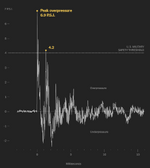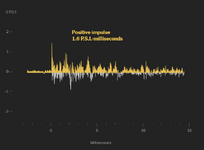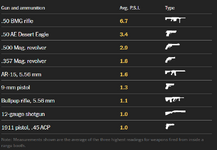A few highlights:
There are thousands of indoor ranges in the United States, and many have a similar layout: A row of lanes separated by bullet-resistant walls. Soft, shock-absorbent paneling is not standard and without it the booth can act like an echo chamber, reflecting more of the blast waves back toward the shooter.
- The initial blast wave from firing a pistol takes only about 2.5 milliseconds to pass through the shooter’s body.
- Soon after, other waves that have bounced off hard surfaces come back toward the shooter’s head.
- Each time the shooter fires, the reflected waves converge, increasing the peak pressure.
- As the waves surge through brain tissue, they bounce off surfaces like the back of the skull.
- If the blast waves are strong enough, neurons can fray or break.
The potential for harm from blast waves gets almost no attention from the shooting public, even though people can experience concussion-like symptoms after a day at the range, said Jeff Balcourt, who is an acoustic consultant for the National Shooting Sports Foundation and a designer of indoor ranges for Balco Defense Company.
“It’s one of those unspoken things,” he said. “You don’t realize that after a whole day of shooting, you have that ringing in your ears and that headache.”
Each blast creates waves of rapidly changing high and low pressure. The power of the blast is typically measured by recording the peak pressure of the biggest wave.
The U.S. military currently says that any blast wave that peaks below 4 P.S.I. is safe — though that guideline is not based on solid evidence, and will likely change as research progresses.
In The Times tests, sensors showed that the booth walls doubled the peak pressure for many guns, compared with shooting in the open. With a .357 magnum revolver, the peak pressure tripled.
The potential for harm from blasts is so poorly understood that even the U.S. military’s official safety threshold — 4 P.S.I. — is not based on real evidence. It’s only a place-holder, borrowed from decades-old guidelines for eardrum injuries. The military uses it because it doesn’t have the data yet to arrive at an evidence-based number for the brain.
The actual threshold for brain tissue damage may be much lower than 4 P.S.I. The Canadian military’s recommended safety threshold is 3 P.S.I. A U.S. Army study found symptoms of brain injury in grenade range instructors who were exposed to hundreds of blasts that measured less than 1 P.S.I.
It’s not clear how low the injury threshold might go. It’s not even clear that measuring peak pressure is the best way to gauge the risk.
The current military safety guideline looks only at a blast wave’s highest overpressure peak. But blast waves have dozens of peaks that can pulse through the brain in a few milliseconds.





